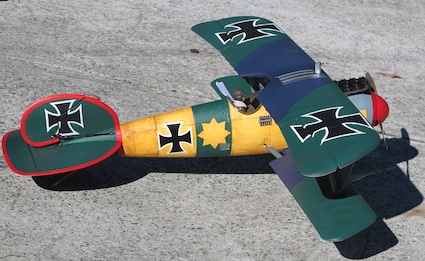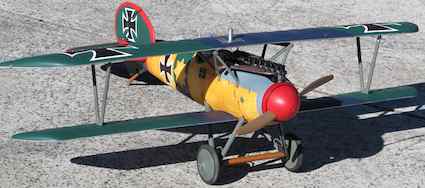 |
Flying High With Electric Power!
The Ampeer ON-LINE!
Fly the Future - Fly Electric! |
Site Table of Contents
| President: | Vice-President: | Secretary/Treasurer: |
| Ken Myers | Richard Utkan | Rick Sawicki |
| 1911 Bradshaw Ct. | 240 Cabinet | 5089 Ledgewood Ct. W. |
| Commerce Twp., MI 48390 | Milford, MI 48381 | Commerce Twp., MI 48382 |
| (248) 669-8124 | (248) 685-1705 | 248.685.7056 |
 | ||
| Board of Directors: | Board of Directors: | Ampeer Editor |
| David Stacer | Arthur Deane | Ken Myers |
| 16575 Brookland Blvd. | 21690 Bedford Dr. | 1911 Bradshaw Ct. |
| Northville, MI 48167 | Northville, MI 48167 | Commerce Twp., MI 48390 |
| 248.924.2324 | 248.348.2058 | 248.669.8124 |
| Mailed Ampeer printed subscriptions are no longer available.
The Ampeer is FREE on-line in Acrobat .pdf format and HTML with active links! | ||
| The Next Meeting:
Date: Thursday, February 14 Time: 7:30 p.m. Place: Ken Myers' house, Commerce Twp., MI | ||
| November EFO Flying Meeting, A surprise meeting; Keith Shaw with his 1905 Wright Flyer, photos of the day, Rick Sawicki's air force and some of Jim M's planes. | December 2012 EFO Meeting - Richard Utkan's multipurpose radio, Roger Wilfong's and Bill Brown's Camp-e Racers, Bob Blau's F-22, Hank Wildman's big Falcon EDF and Ken Myers new O.S. OMA-5010-810. |
| O.S. Engine/O.S. Motor OMA-5010-810 Preview, Ken Myers explains why the battery/prop data presented by both O.S. Motor and Tower Hobbies is incorrect. | Painting and Detailing a Parkzone Albatros DV5a, David Hipperson explains how he painted and detailed his parkzone Albatros DV5a with photos. |
| Some Recommended Winter Reading, Ken recommends some articles to digest this winter. Repeat of January recommendations and only available in the online HTML version. | |
|
The November EFO Flying Meeting was a surprise. The weather had turned and it seemed like winter was coming early. Ken had cancelled the November flying meeting. The weekend of November 10 and 11 turned out to be pretty nice, but Ken did not 'call' a meeting, as he had a prior commitment. 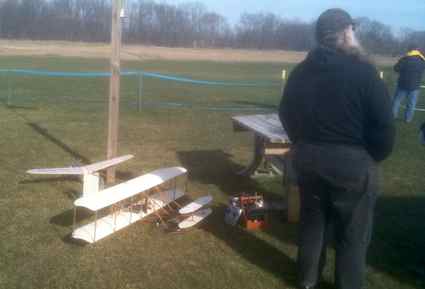
Keith Shaw with his 1905 Wright Flyer As soon as Ken saw that Saturday, November 17 was going to be another pretty good weekend, he called the gathering.  The turn out was excellent and so was the flying weather! A great time was had by all! 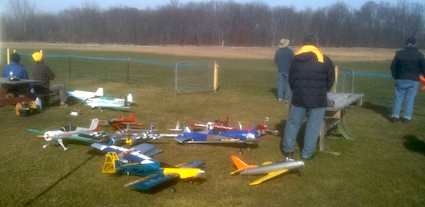 Rick Sawicki brought out a lot of his planes. 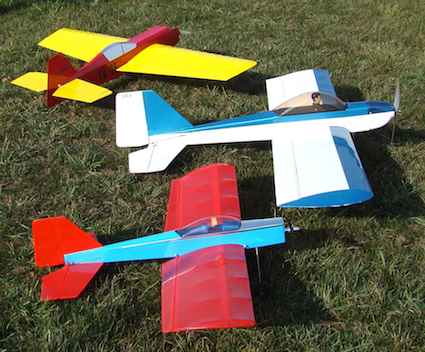 James M. also had some very nice flyers out that day. December 2012 EFO Meeting The monthly EFO meeting was held at Ken Myers' house on the evening of December 13. 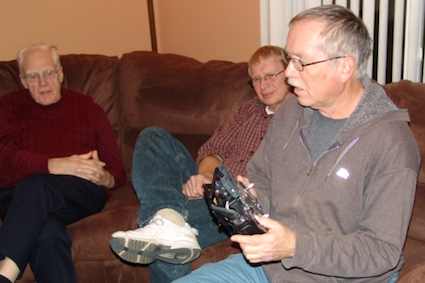 EFO vice-president, Richard Utkan, shared a "new" transmitter that he "created". He recently picked up a nice 7-channel Futaba 72MHz radio at a swap meet for $50. He added a Tactic AnyLink to it. He can now fly any of the Flyzone AnyLink equipped planes with it. He also added a FrSky telemetry system. He now has two 2.4GHz systems for use with his $50 investment. Good job Richard! 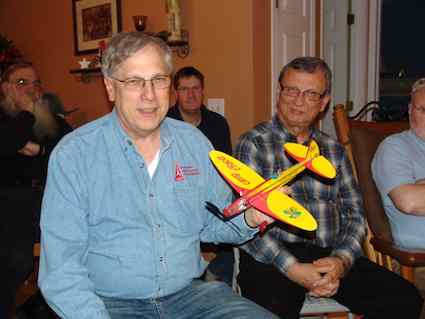 Roger Wilfong shared his Camp e'Racer built from a Retro RC kit.
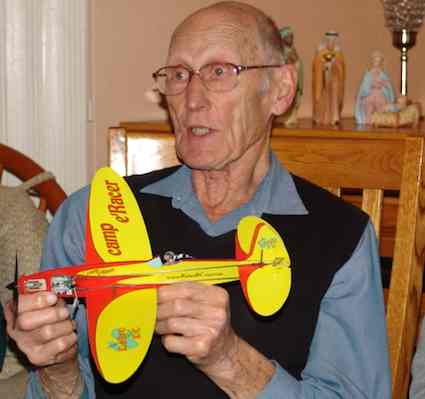 Bill Brown also had his Camp e'Racer. It was also done in the yellow and red scheme. He really likes the way it flies and loves doing slow circuits with it at the Ultimate Soccer Arenas. 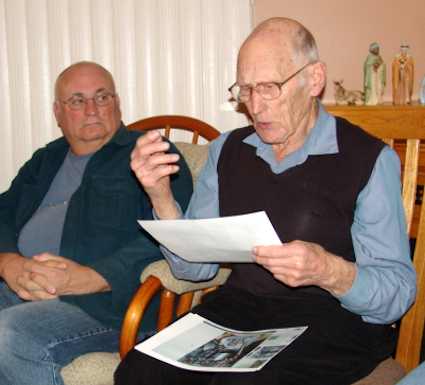 Bill also asked some questions about designing a dummy engine for his Wright Model B. He had some photos of the original engine. Later on, Keith Shaw gave Bill some good ideas of how to replicate it. 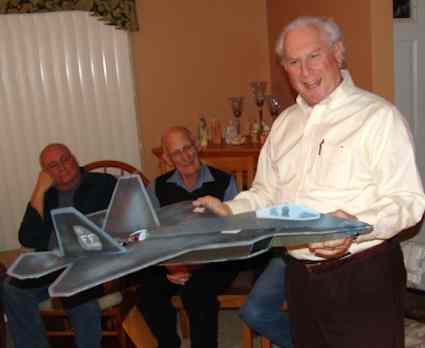 Bob Blau showed off is scratch-built, blue foam, prop through the wing, F-22 Raptor. He had some blue foam left over from other projects. He got the plans off the Internet. It is mostly assembled with hot glue. The prop hole is 'rounded' at the end of the slot to try and keep the inherent noise of this type down a bit. It flies well and presents itself in a very scale manner in the air.
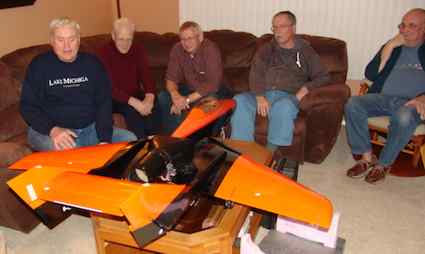 Hank Wildman brought his current project, a Falcon, which looks very much like a Jet-Cat. Hank has done four months of work on it so far. He has done a lot of work to 'beef up' the structure, since the model has broken up in the air before when used with a turbine power plant.
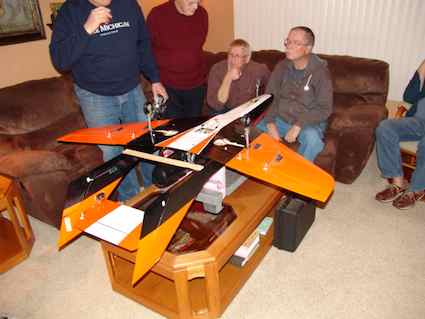 Fantastic job Hank!!! Ken Myers demonstrated the PowerMatch 3-in-1 meter that he reviewed in the December Ampeer.
O.S. Engine/O.S. Motor OMA-5010-810 Preview
Forward While helping a friend select a power system for his new, kit built, Sig LT-25, I found that O.S. Engine/O.S. Motor had added several new sizes to their line of available outrunner motors. The power system goal for the LT-25 is to swing an APC 12x8E through possibly an APC 13x8E at about 400 watts in using a 4S "A123" 2300mAh pack. The glow to electric conversion .xls workbook recommended an outrunner weighing between 175g and 275g and having a Kv between 780 and 865. 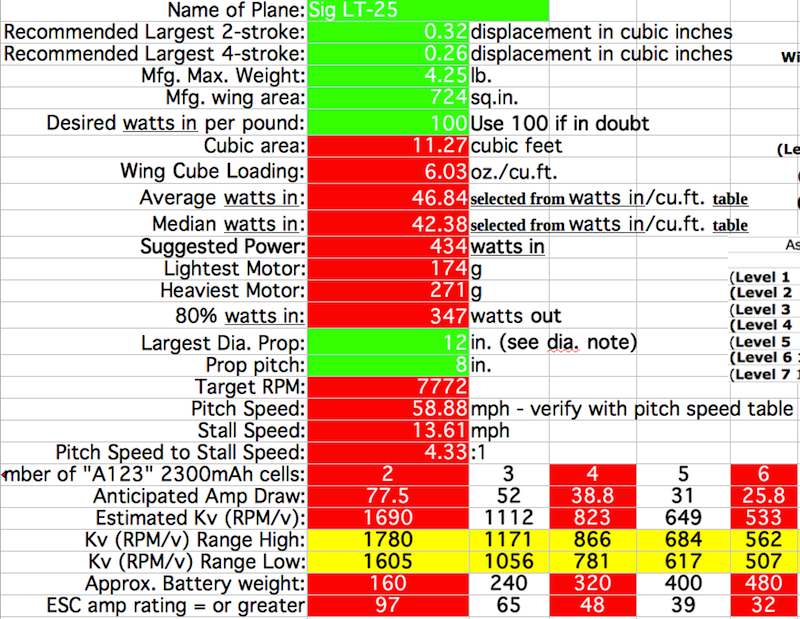 The OMA-5010-810 appeared to fit the requirement with a given weight of 234g and a given Kv of 810. Unfortunately, at the beginning of December 2012, there were no reviews of the real world performance for this motor. I have three O.S. Motor outrunners. They are an OMA-3825-750 and two OMA-3820-1200s. Real world testing reviews appear on the Ampeer Web site. OMA-3825-750 (updated Nov. 26, 2012) The outrunners appear to be well made, and the OMA-3825-750 has been inservice for over a year on the 'club trainer', which gets a lot of flying time. It is holding up well. After testing the three previous O.S. Motor outrunners and gathering real world data for them, it was apparent that the data supplied by O.S. Motor was inaccurate. The motors tested at a higher Kv than stated, and the supplied prop performance data was not accurate. The Two year limited warranty, from a trusted supplier like Tower Hobbies, is a big plus for this motor!
At the beginning of December, 2012*, in the section "NOTES FROM OUR TECH DEPARTMENT", Tower Hobbies stated, "This is the .40 5010-810 Brushless Electric Motor from O.S. Motors." Just a bit further down the page it stated, "FEATURES: For airplanes using a four-stroke .52 cu in (8.5 cc) engine". O.S. Motor's Web site states, "OMA-5010-810 (4-stroke .52 size)" According to www.coastalplanes.com/tools/propchart.htm, a typical 0.48-0.56 4-stroke turns an 11x7 prop at between 10,000 and 11,000 RPM. An APC 11x7 sport prop requires about 630 watts out (Pout) to turn at 10,500 RPM. Depending on the efficiency of the motor, that is about 780 watts in to 830 watts in. It is typical for an electric conversion to use a prop 1 inch to 2 inches larger in diameter than is typical for its 4-stroke "equivalent", if there is ground clearance for the larger diameter prop. This gives one 'clue' as to what diameter prop to consider for this motor. Unlike a glow motor, the same electric motor can be used in much broader applications, but at least it is a start. According to the Tower Hobbies' Web page*, "SPECS: Rated Power: 700W" and "Rated Current: 45A". 700 watts in is noted on the O.S. Motor Web site. 700 watts in / 45A suggests 15.6V or a 4S Li-Po pack. This is quite interesting when compared to the prop performance data table for this motor as supplied by O.S. Motor. Singapore Hobby Supplies gives the maximum watts in as 1310. It appears that they chose the highest wattage noted in the Owner Instruction Manual for this motor. They noted the maximum current as 55 amps. I have no idea where they came up with the maximum amp draw number except that six of the fourteen prop tests are about 55 amps. O.S. Motor gives the maximum current as 80 amps for 5 seconds. Model Engines gives the watts in as 666. This is 14.8V (3.7V per cell for a 4S LiPo pack) times 45 amps. It is interesting that they also use 55 amps as the maximum current. Graupner notes, "Output 885 W". They also noted the "Recommended propeller Best.-Nr. 1326.13x8"" and "Maximum efficiency 85%". The Graupner prop appears to be an APC 13x8E. The O.S. Motor Owner Instruction Manual notes the following for an APC 13x8E; 4-cell, 16.8V, 62A, 1042W, 9930 RPM.
This could be how Graupner derived the Output of 885 W. IF the maximum continuous amp draw is 45 amps, then the amp draw where the motor has an "85%" efficiency has to be less than 45 amps, not more. 9930 RPM / 810Kv = 12.26 Vnet (Vin - back EMF)
The amps in the previous example are well above the 'rated current' (45 amps) and watts in (700) as recommended by O.S. Motor. The Tower Hobbies' Web site* stated, "REQUIRES: 90A brushless ESC" and "Rated Current: 45A". Also on that page it stated, "80-amp ESC was used for the testing". The O.S. Motor Owner Instruction Manual suggests an 80-amp ESC for this motor and a 90-amp for the OMA-5020-490 and OMA-5025-375. This motor is 'rated' 45 amps continuous and 80 amps for 5 seconds by O.S. Motor. A 60-amp ESC should be more than enough, if the amp draw is kept within the O.S. Motor continuous rating. The definition for Continuous rated current (ICR) (Amperes) is the same as for Rated Current, "The maximum allowable continuous current a motor can handle without exceeding the motor temperature limits." The O.S. Motor Owner Instruction Manual states that 80 amps for 5 seconds is the maximum current. This number is a determination made by the manufacturer as to the highest amount of load current a device can reliably carry. The Tower Hobbies' Web page* stated only the, "No Load Current: 1.8A"" without stating the volts. The Io with the applied voltage is an extremely important number when mathematically modeling a given motor. Io is not a constant constant. Io, the no load current, changes slightly with the applied voltage. Io is used to determine the Net Current (Inet) under load. Inet = Iin - Io. It varies slightly with the applied voltage. It is best to have two no load voltages and currents given as well as the RPM for each. The increase, or decrease, of the Io is not directly proportional to a single given Io. With two no load currents at different voltages, the slope can be calculated, and it provides a bit more accurate Io for a given voltage. Note how the Io was used previously to determine the Pout at 62 amps, but it will be 'off a bit' since the slope of two no load amps and volts could not be determined. Again note that the Tower Hobbies' Web site* stated, "Maximum Efficiency: 85%". Theoretical motor efficiency, by itself, is not very useful and can be misleading. The drive efficiency of the brushless motor AND electronic speed control (ESC) must be considered at the anticipated or actual operating current. 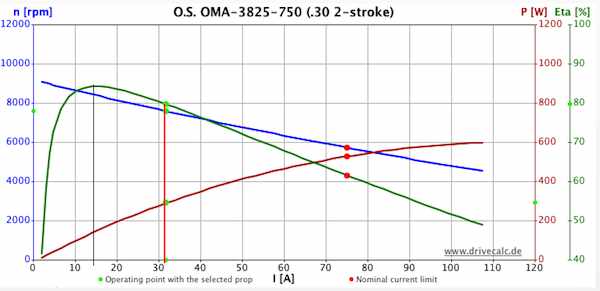
Power Graph The power graph of the OMA-3825-750, this is NOT the OMA-5010-810, illustrates that typical hobby motors are not generally used near their maximum efficiency point, which is just over 84% for the OMA-3825-750 motor at about 15 amps. The 3825-750 is used in the club trainer, with a 4S "A123" 2300mAh battery and an APC 12x8E prop and draws about 32 amps static. The drive efficiency at 32 amps is just shy of 80%, which is actually quite good. OMA 3825-750 Pin = 11.4V * 31.77A = 362.2W
Not surprisingly, 287.7W / 362.2W = 79.44% as indicated by the previous graph. The Tower Hobbies' Web site for the OMA-5010-810 stated, "kV: 810". It is interesting to note the various spellings used by different suppliers and even the manufacturer for the rpm/V motor constant. It is Kv, and it is directly related to Kt (the torque constant). Kv * Kt = 1355 (sometimes the constant is given as 1352) The Tower Hobbies Web site *stated, "Weight: 8.3oz (234g)" 234g is 8.25 oz. Weight in grams is a significant number. It is used, sometimes, to estimate the maximum power by multiplying it by 3 (3 watts in per gram of motor weight). 234 * 3 = 702 watts in. Apparently O.S. used this method. It is NOT exactly valid. The similar 253g Cobra C-3525/10 notes a continuous amp draw of 62 and a Maximum Continuous Power on 6S Li-Po of 1380 Watts in.
Graupner states "All-up weight, approx. 234 g". The given weight usually includes the motor leads and connectors but not the cross mount, and prop adapter. Therefore, the all-up weight is greater than 234g. The Tower Hobbies' Web site* stated, "Length of Motor Can to Backplate: 1.7" (42.5)" and "Diameter of Motor Can: 1.98" (50mm)"
Once the 'can' diameter and length are known, a generic name can be determined for comparing various outrunner motors to each other. The generic name for this motor, based on the supplier's data, is O.S. Motor 5043-810, 234g (volume 84.43 cm^3)
Notice that they have approximately the same 'can' volume and are within 30Kv and 19g of each other. In an effort to help consumers select applications and props for this motor, the Tower Hobbies' Web site* copied the battery and prop data supplied by O.S. Motor. The O.S. Motor prop data is located on their specifications page. The O.S. Motor data is inaccurate and not useful. Unfortunately, Tower Hobbies also included a couple of typing errors of their own; 8S where they meant 4S and RPM 7.380 when they meant 7,380. Tower Hobbies chose only to copy the battery configuration and not the voltages for their Web page. The O.S. Motor specification page shows LiPo Cell 4S Voltage 16.8 and LiPo Cell 3S Voltage 12.6. These are unusual 'test' voltages for the given cells. The voltages they chose to use are the fully charged LiPo battery voltages. Using 16.8V for a 4S LiPo and 12.6V for a 3S LiPo is a problem. When a real LiPo is used there is a relatively large voltage drop in the first few seconds of the discharge. It is typical for user data to be gathered with a power meter within the first 10 seconds to 20 seconds of a battery discharge. 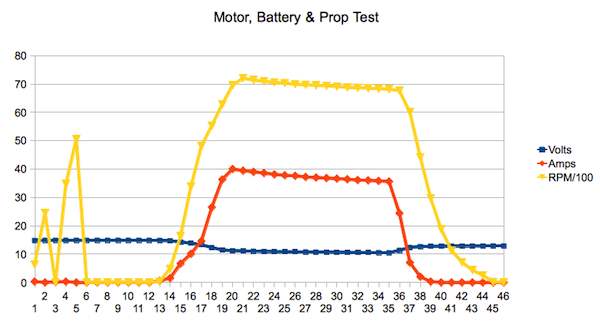 The graph was created from data captured by an Emeter 2 of a real motor, battery and prop test. The data was captured using a fully charged "A123" 2300mAh battery pack using an APC 13x8E prop. The voltage spikes seen near the beginning of the discharge were caused by the Ice 50 ESC initialization. The data was captured over a period of 23 seconds from initialization through the amperage and RPM returning to 0. 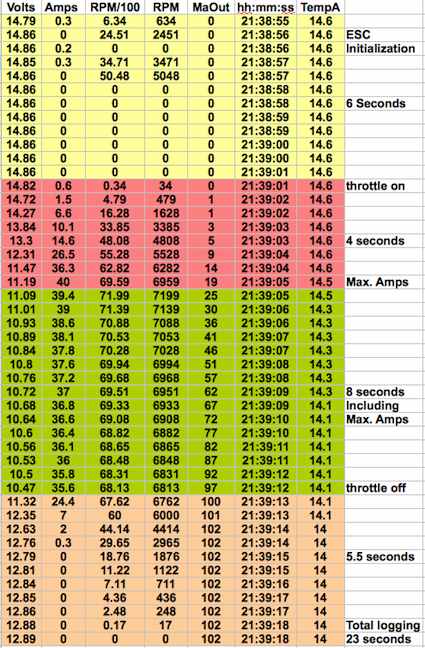 The ESC initialized and rested 6 seconds and the resting battery voltage was 14.86V. From the time the throttle was advanced to the maximum amp draw was 4 seconds. The voltage under load, at the 40 amp draw, had dropped to 11.19V. The power in at that point was 447.6 watts in. As the graph and the data illustrate, it was all downhill from there. Any point from the maximum amp draw to the throttle off amp draw could be used as the stated amp draw or watts in. The maximum amp draw for this motor, battery, and prop combination will never be much higher than the 40 amps measured at 14-deg C/57-deg F. When I share information on powers systems I tend to average, in this case, the 8 seconds from the maximum amp draw to the shut off. To me it is about a 400 "watt" system at about 37 amps and about 7,000 RPM. An equivalent capacity LiPo would be a 2600mAh pack when using only approximately 80% of the pack's capacity for the 'good health' of the LiPo. According to Drive Calculator, about 655 watts out are required to turn an APC 12x8E prop at 10,300 RPM at an elevation of 287m and 15-deg C ambient temperature. It is important to note the elevation and ambient temperature. The first line of data on the O.S. Motor specification page and repeated on the Tower Hobbies' Web site* is:
To turn an APC 12x8E at 10,300 RPM 'requires' about 655 watts OUT. 655Wout / 857Win = 0.764294 or 76.4% drive efficiency. That is a somewhat realistic drive train efficiency for an outrunner. The second line of data on the O.S. Motor specification page and repeated on the Tower Hobbies' Web site* is:
To turn an APC 12x10E at 7,380 RPM 'requires' about 369 watts OUT. 369Wout / 680Win = 0.5426471 or 54.3% drive efficiency. That is an unrealistic drive train efficiency. The voltage decreased but the amp draw increased to greater than that of the APC 12x8E at 16.8V. It is to be expected that the 12x10E would draw more current at 12.6V than the 12x8E, but not more than the 12x8E at 16.8V. The rest of the 3S, 12.6V data is also inaccurate. The other APC 12x8E in the O.S. Motor prop data chart is the last example in the table:
To turn an APC 12x8E at 9,300 RPM 'requires' about 472 watts OUT. 472Wout / 945Win = 0.4994709 or 49.9% drive efficiency. That is very unrealistic because when less voltage is applied to the the same motor and prop combination, the current and wattage should drop, not increase as they did in this example. The prop table data lines 8 through 13 are definitely inaccurate. They show an input voltage of 12.6V, yet the Vnet, RPM / Kv, is higher than the input voltage. Data line 13:
10,400 RPM / 810Kv = 12.84Vnet Data lines 8 through 12 have even higher RPMs stated. There are 14 examples in the prop performance table. Thirteen of the examples shown are rated above 45 amps, the continuous rating by O.S. Motor. There was one more absolutely glaring error from just 'looking' at the data.
There is no way for this to happen. It is admirable for suppliers like O.S. Motor and Tower Hobbies to give battery and prop information. Unfortunately, their information is not valid. Only Mission Modelisme in France tried to simplify the prop selection and stated, "Helices compatibles helices 12x8 a 14x10". Suppliers should always make clear what battery/voltage goes with which prop. Many users are confused by this. Something like this would be much clearer for everyone.
O.S. Motor brushless outrunner motors seem to work well and to be produced from decent materials. Unfortunately, the battery/voltage and propeller combinations they state appear to be 'fantasy' numbers. So far, their Kv numbers have not been very accurate either. These numbers are not very useful in helping the end user to decide whether to purchase an O.S. Motor outrunner or not. I am satisfied enough with O.S. Motor outrunners to have recently purchased another, my fourth. I wish that O.S. Motor would provide more accurate information to its worldwide suppliers. Reference sites: O.S. Motor - Main brushless motor page O.S. Motor - Brushless motor dimension page
O.S. Motor - Brushless motor specifications page
Hobbico - Owners Instruction Manual for the O.S. Brushless Motors OMA-5010-810/OMA-5020-490/OMA=5025-375
Graupner - Germany (who appears to be European distributor) - specifications
Singapore Hobby Supplies - Singapore - specifications
Model Engines - Australia - specifications
Mission Modelisme - France - specifications
* All the Tower Hobbies statements were gathered from their Web site page for this motor at the beginning of December, 2012. They may change over time.
Painting and Detailing a Parkzone Albatros DV5a
Just prior to Christmas I purchased a Parkzone Albatros. I must admit to being very fond of the PZ products having had from their "scale" range a T-28, Bf 109, Wildcat and SE5a. Each has performed perfectly and given great service which I suppose means that must mean that they are good value for money. The T-28 and SE5a have been absolutely superb. So, always being an Albatros fan anyway I just had to get one.
I'll be honest and say that the least appealing part was the colour scheme, which I believe was supposed to be von Richthofen's mount. From my perspective it looked a little too toy like for me so a repaint was on the cards. Though I went through my library I did not want to plunge into the "lozenge" camouflage but I did come up with the one shown that purports to be the mount of a Leutnant Klein of Jasta 5. On my example the decals on the upper wing and that on the fin/rudder were very bubbly and peeling around the edges. So, after taking a deep breath these were peeled off and the residue of any adhesive carefully removed.
The scheme is not absolutely right as I wanted to hold on to the fuselage decals which meant a slight adjustment to the proportions of the green band and star. All of the foam painting used artist's acrylics and were simply brushed on. Three paper templates were cut and used for making the crosses and star but no masking was used. Plastic components were painted using Humbrol oils which I guess are similar to US Floquil paints for plastic kits.
The tyres were lightly sprayed with matt aerosol enamel to change from pale grey to sort of black.
The whole job took around 15 hours and the Albatros is delightful in the air. Can't send you any airborne photos at this time as we are not using our flying field due to the danger of summer bush fires but hope to pass some on as soon as possible. I have now added the engine inlet manifolds and coolant pipes but am not bothering with rigging simply out of practicality.
Some Recommended Winter Reading
This time of year is a good time to check out some of the articles on the EFO site.
There are several articles by Keith Shaw, while some may consider them a bit 'old', they are still valuable reading.
Keith Shaw gave a talk to the EMFSO (Electric Model Flyers of Southern Ontario) on proper electric powered RC design, and it was transcribed by Martin Irvine of Kingston, Ont. in 1992. This is a timeless "How to" on designing electrically powered RC planes. It is in Adobe Acrobat .pdf format. The original was broken into four parts to be sure that it would fit on floppy disks. Patrick Surry has combined the original four parts into one.
www.theampeer.org/shaw/ShawConstructionNotes.pdf
He also made a version to view on a phone, Kindle, etc.
Other Keith Shaw articles include;
Keith Shaw's "Electric Sport Scale" article from the July 1987 Model Builder
edited and commented on by Ken Myers, July 1989
Keith Shaw's "Charging Into Electric Flight" - A Primer from the Master, Radio Controlled Sport Flying, January 1994.
Keith Shaw's "The Art of Low Power Aerobatics: Maximize your performance with energy management" originally in Model Airplane News, Feb. 1996. Keith describes how to reduce drag, set up the CG properly using the "Dive" technique and get the most from your plane for the least power.
The Complete Ampeer Index is located at http://www.theampeer.org/ampeer/Complete-Ampeer-Index.html.
For some recent outrunner motor reviews;
O.S. OMA-3820-1200 Review where Ken reviews this O.S. ".25-size" 'racing' outrunner and makes prop suggestions.
O.S. OMA-3825-750 Review where Ken reviews this O.S. ".30-size" outrunner and makes prop suggestions.
O.S. Motor OMA-5010-810 a preview of this motor and why the battery/prop data is incorrect.
| ||||||||||||||||||||||||||||||||||||||||||||||||||||||||||||||||||||||||||||||||||||||||||||||||||||||||||||||||||
To Reach Ken Myers, you can land mail to the address at the top of the page. My E-mail address is: KMyersEFO@theampeer.org
